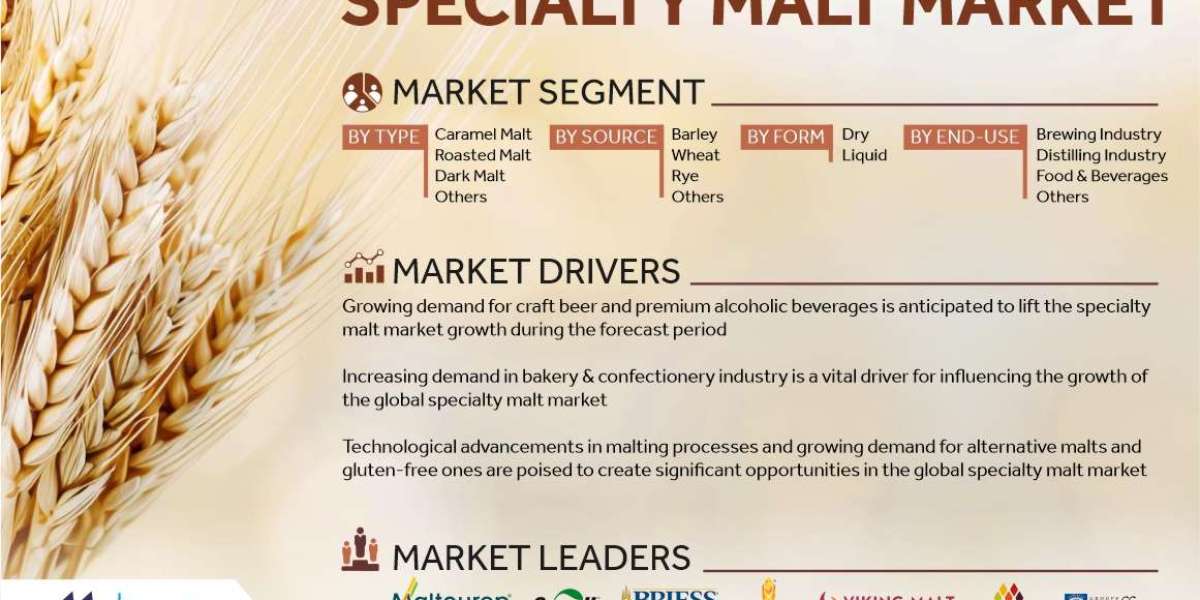The global Specialty Malt Market is poised for substantial growth over the next decade, with market revenue projected to surge from USD 2,933.97 million in 2025 to approximately USD 4,224.16 million by 2035, growing at a compound annual growth rate (CAGR) of 4.5%. This growth is driven by the rising demand for unique, flavor-enhancing ingredients across the food and beverage industries, particularly in craft beer production, baked goods, and malt-based beverages.
Specialty malts are malted grains that undergo specific processing techniques—such as roasting, kilning, and caramelization—to develop distinct flavor, color, and aroma profiles. Unlike base malts, which primarily contribute fermentable sugars, specialty malts are valued for their sensory enhancement capabilities. These malts are increasingly being adopted by craft breweries, distilleries, artisanal bakeries, and manufacturers of non-alcoholic beverages aiming to differentiate their products in a competitive marketplace.
Why Specialty Malts Matter
Specialty malts differ from conventional base malts in one key area: their sensory impact. While base malts provide the bulk of fermentable sugars in brewing and food production, specialty malts are used to enhance taste, texture, aroma, and color. These malts don’t contribute much to fermentation but are indispensable in creating product diversity and distinction.
Whether it's the deep cocoa notes of chocolate malt, the toffee richness of caramel malt, or the nutty crispness of biscuit malt, these ingredients play a pivotal role in crafting beers, breads, and beverages that stand out on crowded shelves.
Market Segments
By Type
Caramel Malt
Roasted Malt
Dark Malt
Others
By Source
Barley
Wheat
Rye
Others
By Form
Dry
Liquid
By End-use
Brewing Industry
Distilling Industry
Food & Beverages
Others
Key Growth Drivers
- Craft Beer Revolution
The craft beer segment has seen explosive growth over the past decade, and it's not slowing down. Craft brewers rely heavily on specialty malts to create differentiated beer styles, from IPAs to stouts and porters. These malts allow brewers to experiment with complex flavor profiles and distinctive appearances, meeting the growing consumer demand for diversity and authenticity in alcoholic beverages.
- Bakery and Confectionery Applications
In the bakery industry, specialty malts are prized for their enzymatic properties and their ability to improve crust coloration, texture, and taste in baked goods like breads, rolls, cookies, and pastries. They also extend shelf life, a crucial factor in modern food production. Confectioners, too, are incorporating these malts to enrich the flavor and color of their sweet treats.
- Non-Alcoholic Malt Beverages
Malt-based beverages are gaining traction in regions like Asia-Pacific, the Middle East, and Africa due to their health appeal and cultural compatibility in alcohol-restricted environments. Specialty malts help producers create rich, complex non-alcoholic beverages with the appearance and taste of traditional malt drinks, attracting a broader consumer base.
- Clean Label and Premiumization Trends
As consumers become more health-conscious and ingredient-aware, there is a noticeable shift toward clean label products—those made with recognizable, natural ingredients. Specialty malts, being minimally processed and naturally derived, align well with this trend. Additionally, premiumization in food and beverage products—where customers are willing to pay more for quality—is pushing manufacturers to utilize high-end ingredients like specialty malts.
Rising Consumer Demand for Craft and Artisanal Products
The global craft beer boom is one of the primary catalysts propelling the specialty malt market. Consumers are gravitating toward premium beverages with complex flavor profiles, which has pushed microbreweries and large-scale beer manufacturers alike to explore a variety of specialty malts, such as caramel, roasted, chocolate, and biscuit malts. These ingredients allow brewers to fine-tune bitterness, mouthfeel, and color, enabling a more customized product range.
Beyond brewing, the bakery industry is witnessing increased utilization of specialty malts to enhance bread crust color, add sweetness, improve shelf-life, and deepen flavor. These malts are also becoming common in cookies, cakes, and cereal bars, aligning with consumer preferences for natural ingredients and authentic flavors.
Challenges: Supply Chain Vulnerabilities and Price Volatility
Despite optimistic growth, the specialty malt market faces significant headwinds. One notable concern is the volatility in raw material prices, exacerbated by global climate issues and geopolitical disruptions. For instance, the “chocolate crisis” of 2024—driven by climate change, poor harvests, and crop diseases—sent cocoa prices soaring, impacting the confectionery industry’s cost structure.
Similarly, record-high butter prices strained bakery operations, reflecting the vulnerability of food processing industries to agricultural supply fluctuations. These events underscore the pressing need for strategic sourcing, robust supply chain management, and cost mitigation strategies among stakeholders in the specialty malt value chain.
Future Outlook and Strategic Opportunities
Sustainability: Manufacturers are increasingly exploring eco-friendly malting techniques and local grain sourcing to reduce their environmental footprint.
Product Innovation: Introduction of novel malt varieties with unique sensory profiles will allow manufacturers to cater to evolving consumer preferences.
Digitalization: Integration of digital tools in supply chain logistics and quality control can enhance operational efficiency and product consistency.
Moreover, strategic partnerships between maltsters, breweries, and food companies can lead to co-developed products and shared R&D resources, fostering long-term market resilience and growth.
Key Players:
Malteurop Groupe
Cargill, Inc.
Briess Malt & Ingredients Co.
Simpsons Malt Ltd.
Viking Malt AB
Muntons PLC
Soufflet Group
Boortmalt Group
GrainCorp Malt (United Malt Group)
Rahr Corporation (Rahr Malting Co.)
Dingemans Malt
The Swaen
Bestmalz (Palatia Malz GmbH)
Holland Malt
IREKS GmbH
Castle Malting S.A. r
Explore More Reports:
Medical Simulation Market: https://wemarketresearch.com/reports/medical-simulations-market/1710
About We Market Research:
At We Market Research, we are passionate about data, insights, and helping businesses thrive in an ever-evolving marketplace. Our journey began with a simple yet profound belief: Informed decisions lead to sustainable success. With this principle at our core, we've grown into a dynamic and innovative market research company dedicated to providing you with the knowledge and strategies you need to navigate the complexities of your industry.
We provide a comprehensive range of research services, including brand perception research, pricing analysis, customer segmentation, competitive analysis, product development and innovation studies, market sizing and forecasts, and more. Our objective is to give our clients a comprehensive insight of their market environment so they can improve their competitive advantage, optimize their strategy, and drive growth.
Contact Us:
Robbin Joseph
Phone: +17246183925
Email: sales@wemarketresearch.com
Location: United States 99 WALL STREET, #2124 NEW YORK, NY 10005



